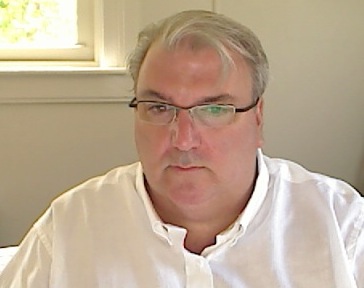In CYBERWORLDS’2014 we have a very special event called Art Show, in which Prof. Bill Seaman (Duke University, USA) will give us a great overview about his wonderful and exciting work. The presentation is schedule as a third invited talk; conference delegates are also encouraged to see some of his creations at the conference venue (take a look at the videos indicated below for a better insight about his exciting and innovative projects).
Prof. Bill Seaman
Media Researcher and Artist
Professor – Duke University, USA
Biography:
Seaman’s work often explores an expanded media-oriented poetics through various technological means— Recombinant Poetics. Such works often explore the combination and recombination of media elements and processes in interactive and generative works of art. Seaman explores image/music/text relations in these works, often creating all of the media elements and articulating the operative media-processes involved. He is self-taught as a musician/composer. Early on he discussed his notion of Structured Improvisation, employing specific fragments of his own improvisations as a compositional method. Initially explored via tape loops and layering processes, he now facilitates this compositional methodology using the computer. He has been interested in meaning production and has explored ideas around computational meta-meaning systems— systems that enable a user to become mindfully aware of how meaning is arising and changing through their interaction. He is deeply interested in new forms of computation, learning systems, the concept of creating an electrochemical computer, as well as the concept of Computational Creativity – both using the computer as a creative tool, as well as articulating the future of creative potentials as explored via computational devices – the creation of creation.
He has won a number of awards including two awards from Ars Electronica in Interactive Art; Intel Research Gift (3 years); Awards in the Visual Arts – Rockefeller Foundation; Fulbright Distinguished American Scholar (Senior Technological Specialist); International German Video Art Prize; NEA Fellowship; Semens’ Stipendium; and Leonardo Award for Excellence, among others. He has been commissioned on a number of occasions including William Forsythe and Ballett Frankfurt (Sleepers Guts) for video/set design; the Museum of Image and Sound – MIS Museum, Sao Paulo, Brazil – Architecture of Association (with Daniel Howe); Tanz_Performance Köln – Inversion (with Regina van Berkel); Vision Ruhr — Exchange Fields (with Regina van Berkel); National Gallery of Canada — Red Dice | Des Chiffré; Greatwoods & Leonard Slatkin, Guest Conductor Pittsburgh Symphony — Pictures at an Exhibition (video for live performance); and the Contemporary Art Television Fund (CAT) – The Water Catalogue.
More recently he has been exploring notions surrounding Recombinant Informatics — a multi-perspective approach to inventive knowledge production. The work The Insight Engine explores interactive Koestler-like bisociation processes for the exploration of crossing disciplinary boundaries and stimulating unconventional thought in research. This generative experimental search-engine work was funded by the Duke Institute for Brain Sciences and Bass Connections – The Brain and Society. Seaman is currently working on a series of art/science collaborations — poetic installations and scientific research papers. The book Neosentience | The Benevolence Engine with Otto Rössler has come out through Intellect Press. Ongoing discussions with Rössler and a new book are in the works. He is also collaborating with artist/computer scientist Daniel Howe on multiple works exploring AI and creative writing/multi-media and has completed an album of experimental music with Howe entitled Minor Distance. He has developed a new generative work and is undertaking interface research with Todd Berreth. He has also collaborated with Craig Tattersall from The Boats, The Humble Bee, The Remote Viewer et. al. They have finished a large audio work (over 7 hours) entitled Light Folds and are working on a new album. He is also collaborating with vocalist Marissa Bergmann on a new series of sonic works. Seaman recently became a member of the Fitzpatrick Institute for Photonics at Duke and is working on a collaboration with Tuan Vo-Dinh, the Director of the institute, on a project called the Light Data Domain exploring multi-modal sensor transductions and speed of light data transfer. He is a member of the Duke Institute For Brain Sciences. He co-runs The Emergence Lab with John Supko, Media Arts + Sciences at Duke University. Seaman and Supko are also working on a book related to Generative Arts.
Seaman studied at Rhode Island School of Design (Foundations, Video and Sculpture), The San Francisco Art Institute (Video, Sculpture, Performance, Installation), MIT (Master of Science in Visual Studies), and the University of Wales where he explored Advanced Inquiry in Interactive Art for his PhD. For further information, please visit: Billseaman.com
For music see also:
Light Folds: http://light-folds.tumblr.com
Minor Distance: http://minor-distance.tumblr.com.
Some of his artworks are shown at the links:
Engine of Many Senses (also called An Engine of Many Senses): http://athanasius.trinity.duke.edu/projects/ems/ems.html
Engine of Engines: https://www.youtube.com/watch?v=c6iENftQThc&feature=youtu.be
A China of Many Senses: http://vimeo.com/36984212
The Architecture of Association:http://projects.visualstudies.duke.edu/billseaman/seamanhowe/aoa/aoa.htm
Title of the talk: «Generative Works: From Recombinant Poetics to Recombinant Informatics»
Abstract of the talk:
Seaman has been active in the creation of differing Cyberworlds from the early 90’s onward. This paper will cover historical approaches including The World Generator / The Engine of Desire (1996 to present) a generative virtual environment—exploring Recombinant Poetics; The Architecture of Association (with Daniel Howe); Engine of Engines (Howe | Seaman) (2011 – present); the more recent generative Cyberworld systems — A China of Many Senses (2011/2012), and The Many Senses Engine (2013 – present) and The Insight Engine (2014) exploring Recombinant Informatics — an exploratory approach to bisociational transdisciplinary research. He will discuss his collaboration with John Supko – including the co-leadership of the new Emergence Lab at Duke University in the new Media Arts and Sciences program. Seaman also has long term plans related to an integrated network of focused sensing, dynamic virtual environments, recombinant Informatics, and speed of light computation – The Light-Data Domain, A collaboration with Tuan Vo-Dinh, head of the Duke Fitzpatrick Institute for Photonics.
